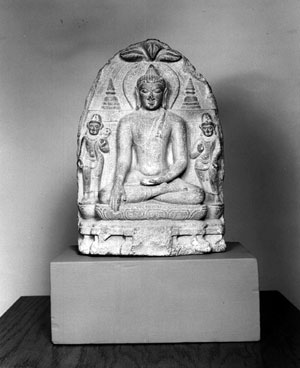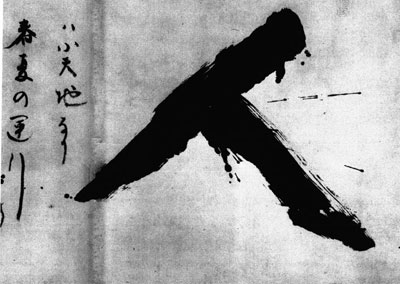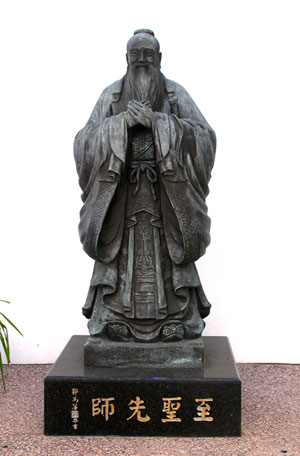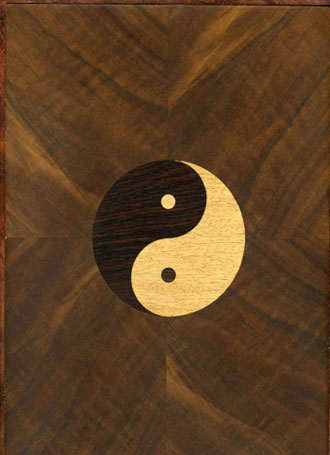 |
BUDDHISM
Buddhism: Truth Is Within the Mind
The original enlightenment of Siddhartha Gautama (560-480 B.C.), as he was sitting in meditation under the Bodhi (fig) tree, became the foundation for a philosophy that has swept across the globe to become one of the world's great religions. Siddhartha gave up the luxuries of his high station in life to search for the answers to human suffering and understand the true meaning of life. He joined the ascetics who lived in the forest, depriving himself of bodily comforts. By severing himself from all attachments in this material world, he hoped to find salvation in the spiritual world. Close to death from starvation, he was struck with the realization that despite his years of sincere effort, he was no closer to any insight.
|
Consequently, he took food and water to bring himself back to health. That night, with renewed strength, he sat under a Bodhi tree in meditation. As the dawn's light peeked over the horizon, Siddhartha was awakened and filled with inner happiness and peace. He knew the answer to the problems of life. He was called to share this knowledge with the world.
Buddha's Message
Buddha's message is simple and consistent: Follow the Middle Way. Neither extreme,
worldly pleasures nor ascetic denial makes you happy. The way of moderation
is the true path to follow. Buddha expressed his teachings as Four Noble Truths.
First, we must recognize that suffering and frustration are part of life. We
suffer from pain, sickness, and inevitable death. Second is that this suffering
comes from clinging, craving, and grasping; the world seems to offer many comforts
and pleasures, but these are not satisfying. The third truth reveals that the
cause of suffering can be eliminated by giving up craving. Finally, the way
to let go of craving is by following the Eightfold Path: right views, right
aspirations, right speech, right behavior, right livelihood, right effort, right
thoughts, and right contemplation. The first two involve coming to an understanding
of the human condition. The next four teach us how to abandon worldly entanglements.
The final two help us develop skills in meditation, the inner mental practice
of Buddha's Way.
The Evolution of Buddhism
Buddhism formally split into two main branches: Mahayana and Hinayana, later
named Theravada. The Theravadins remained true to the original teachings of
Buddha. This branch holds that each person, arhant, follows the Eightfold
Path through secluded contemplation in a monastery to find nirvana (enlightenment).
To be an arhant, a saint, reaching nirvana individually, is the Theravadins'
idea of perfection. Simple, austere, and traditional, this form of Buddhism
has flourished most strongly in Southeast Asia.
Mahayana is the more innovative form; by adding a multitude of variations, sects,
and Buddhas, it has made Buddhism a religion for the masses throughout the world.
The Mahayana ideal, the bodhisattva lives differently from the Theravadin
arhant, who retires from everyday life to quietly rest at peace in nirvana.
Once enlightened, the bodhisattva turns away from nirvana and returns to the
world to enlighten others. Not until all are free from suffering can the bodhisattva
be free as well. We are all one; therefore, no one may be excluded--all must
be enlightened equally. Salvation for all means that all are held sacred. The
modern interpretation leads many Buddhists to involve themselves with peace
movements, environmentalism, and many kinds of benevolent action.
Buddhist Sutras
Buddhists also believe that wisdom can be achieved by reading and studying
sutras. Sutras are ancient writings, originally attributed to Buddha, that were
compiled over the centuries following his death. Many different sects of Buddhism
have been inspired by the message of particular sutras. Sutras push the limits
of intellectual thought in addition to providing spiritual inspiration.
The Diamond Sutra, written about A.D. 350, is one of the oldest books
still in existence. The original sixteen-foot scroll can be seen at the London
British Museum. In this sutra, a part of the larger Wisdom Sutras, Buddha answers
questions asked by Subhuti, one of his disciples. Buddha explains that seekers
of the Way must give up their usual modes of thinking and experiencing. The
answer requires a different kind of thinking than logic and reason. To help
people discover this state of mind, the sutra presents a paradox: "It neither
is nor is not" (Diamond Sutra). The seeker may use reason along the way,
but eventually it must be discarded. Reason is like a boat, a raft to cross
the river. It is useful to get you across, but once you reach the other shore,
it should be discarded.
The Heart Sutra, another work from the Wisdom Sutras, is a short work
that persuasively describes the true nature of reality as Buddhism views it:
"Form is emptiness and emptiness is form." The enlightened person knows that
all things are impermanent and in this way empty. Yet, our senses tell us that
there is much to experience; form seems very real. With Buddhist insight, people
can experience the relative reality of things in this world and yet realize
that ultimately nothing is real. This sutra is chanted daily in many Zen temples
as a mental corrective for clearing the mind.
The Avatamsaka Sutra is a large collection of works, spanning the first
to fourth centuries. This sutra is based on another important principle in Buddhism,
that all objects are interrelated and interpenetrate one another. The universal
is reflected in the individual, and the individual is reflected in the universal.
All is contained in the one, and the one is in all.
The Importance of Meditation
Buddhism emphasizes meditation as the only effective pathway to wisdom. Many of the sutras teach people how to meditate. The Diamond Sutra, the inspiration for the founding father of modern Zen, Hui-neng, gives this instruction for meditation: "The mind should be kept independent of any thoughts that arise within it" Truth is within the mind, detached from the problems of everyday life and even detached from the self. Buddha rejected having a concept of self. Self is empty; truth is empty--beyond good and evil, beyond all duality, and even beyond concepts or words. As Buddha said, "Truth is undeclarable." This truth is called buddhahood.
Buddhism confounds logic further by explaining that attaining buddhahood is not really attaining anything. Buddhahood is nonattainment, release. Everyone already has the capacity within to achieve nirvana, but few come to realize it. Wisdom is accessible to all who sincerely turn attention inward and meditate.
For more indepth information, see Simple Buddhism and Buddhism in Ten.
|
When you follow Zen's path
Through action with heart
Chaotic worlds of discord
are a symphony of art
--C. Alexander Simpkins

ZEN BUDDHISM
Zen has been a powerful force in the world. It has made an odyssey across time and place, circling the globe in a span of 2500 years. From its early origins in India in 600 BC Zen has continued to evolve throughout China, Korea, and Japan, and its influence now extends beyond the East into Europe and America.
Zen continues on its journey around the world, carrying a positive spirit that continues today. Zen is a phenomenon that has not only survived for 2500 years but flourishes anew. Why does this ancient religion still speak to us today?
Zen Develops
From its earliest inspiration 2500 years ago in India, Zen has left its mark on the world. India was the intellectual origin of Zen, developing a philosophical view that revolutionized religion and set the foundation of Zen. When China encountered Buddhism, a creative integration took place. “Ch’an”,which means Zen, grew and developed there, becoming part of the Chinese mind. China served as the center for certification, not only as the early source of Zen for the world. Many monks made the arduous pilgrimage for direct transmission of the dharma, then returned to plant Zen on new soil. The Japanese took the spirit of Zen and made it their own. They added method, enshrined the tradition to preserve it through disciplined instruction. The Japanese Way of Zen took many forms through the development of Zen arts that help the human spirit transcend. Korea took a different path, unifying meditation with Buddhist studies and sudden enlightenment with gradual cultivation. Through Zen’s many seasons, it blossomed anew with every spring.
Zen Inspires
Zen encourages us to awaken to a profound feeling about life. It touches the hearts of humankind everywhere, to help rekindle a deeper, spiritual experience of our own true nature as one with the universe. Everyday life becomes more meaningful when transformed through Zen. How has this come about, and what will evolve?
Zen always reaches beyond the relative, into regions of consciousness that touch human potential. How much can we know about the true nature of ourselves and reality? As Zen asks these questions here in the West, inevitably, there will be interactions with the disciplines that ponder these issues, such as philosophy, psychology, and physics. Can we find answers to questions that our logic can not answer? Zen points the way.
Zen challenges us to discover our best innermost being. What we do with this discovery is up to us. When Bodhidharma, the Indian monk who brought Zen to China, sat staring at a wall for nine years, or when Dogen, the famous Japanese monk who was willing to give up every worldly possession down to the shirt on his back so that he could be free to devote himself fully to his Zen, we wonder what we personally do for the tasks our lives have presented us with. Search deeply within your own being to find your higher life’s task.
Zen seeks answers to life’s questions deep within the individual. Zen practice discourages useless strivings and turns you back to the wellsprings within your mind. True happiness and wealth can never come only from things outside of yourself. Zen offers a corrective for the excesses of contemporary life. The Zen “Way” points to deeper values that can help you realize your potential, unfolding in creative ways.
Zen Meditation
Meditation is the cornerstone of Zen. Without people actually engaged in meditating, there would not be Zen. The Japanese word "zen" translate as "meditation". Meditation is the means to experience Zen for yourself. Dogen, the founder of Soto Zen in Japan, believed that zazen (seated meditation) was the right entrance to the Buddha Dharma. Since meditation practice itself is enlightenment, there is nothing outside the mind to seek, and nothing outside meditation to do.
Zen mediators let go of focusing on things and self to discover the calm, the silence within. This is not done by turning attention on the outer environment, but rather by sitting quietly with oneself, observing thoughts as they come and letting them go.
Zen Enlightenment
Meditation brings about a unique experience: the stream of thinking quiets, consciousness becomes clear and empty, awareness is moment to moment, fully present. Then something can happen: enlightenment. This self awareness does not come from outside you. When Buddha realized his enlightenment under the bodhi tree, he suddenly knew that the potential for the experience had always been there. Zen Buddhism is an optimistic philosophy in which all people have the capacity for enlightenment latent within. As Lin Chi, a famous Zen master and founder of the Rinzai sect of Zen said, "Nothing is missing!" Enlightenment is a capacity that is already present, a sixth sense. The experience is always your own.
Realizing enlightenment is like waking up from a dream, leaving shadows of former, limited views behind. Enlightenment welcomes wholeness in the present moment of awareness. "When the ten-thousand things are viewed in their One-ness we return to the Origin and remain where we have always been." (Zen master Sheng-Ts'an)
For more indepth understanding of the development and practice of Zen Buddhism see these books: Simple Zen: A Guide to Living Moment by Moment and Zen Around the World: A 2500 Year Journey from the Buddha to You and Zen in Ten.
|
 |
Seek higher goals
To which you aspire
Don't base your actions
On lower desires
True happiness
is not found
In mere pleasure
Benevolence is
An invaluable treasure
--C. Alexander Simpkins
CONFUCIANISM
Confucian philosophy has had a profound effect on Asian society and politics for many centuries, but its effects have also been felt by the entire world. Ralph Waldo Emerson lauded Confucius as "the George Washington of the world of thought." Voltaire said that "to realize the theories of Confucius would bring about the happiest and most valuable period of human history. Confucianism addresses how people should live with each other at their best, amidst their life-situation, and points to the inner source of guidelines to follow for conduct.
Confucius stands out as one of the supremely great figures in the world's history. European philosopher Karl Jaspers grouped him in a book with Socrates, Buddha, and Jesus. Yet Confucius would have been the first to tell us that he was just a man like any other. His ideas inspire our better natures to express themselves, and perhaps it is this effect that makes him so important to humanity.
|
| Confucius is regarded as the First Teacher in China. He began to teach at twenty-two
and had students immediately. He opened the doors of his school to anyone who
was sincerely willing to learn. His fees were low, whatever could be afforded
by the learner. One student paid him a bundle of dried meat! Confucius instilled
his love of learning and ideals to his students. He wanted his students to learn
how to think for themselves. Confucius devoted his life to teaching. Over his
lifetime he taught 3000 students. The names of seventy-two of his best students
are still remembered today. They were instrumental in recording his sayings
and carrying his work forward.
Confucius was a large man with a gentle disposition who enjoyed music and dance.
An entry in the Analects characterized him as friendly while also dignified,
grand but not fierce, respectful, while also relaxed. He offered his own autobiography:
At 15, I had set my mind on learning. At 30, I could stand on my own feet.
At 40, I was determined not to be led astray by irrelevancies. At 50 I fully
realized what destiny had in store for me. At 60, I could follow a truth without
fuss. At 70, I could let my action follow my heart's desire without transgressing
the standards of right. (Confucian Analects 14)
Confucian Virtues
Nobility is a function of how we live. What we are in character is molded by
what we do. Our actions matter and can lead to social harmony, expressed in
tradition, honor, and virtue. Confucius distinguished a number of virtues: humanness
(jen), filial piety, loyalty, duty, sincerity, righteousness, and propriety.
The most central virtue, jen is human-heartedness. This primary quality
was interpreted in various ways by the generations that followed Confucius.
Jen translates as true personhood, being fully human. The true self is honest,
forthright, correct. These qualities are the givens of humanity. All we need
to do is be true, genuine, and sincere. Whether we develop them is a matter
of choice. Confucius taught his students to cultivate these qualities.
Virtues are action-oriented, practiced in relationship with others and in relationship
to yourself, even when you are alone. To Confucius, human beings use values
to guide their lives. The wise person does not attempt to separate reality from
value. "Is" includes "ought." Facts have a vector quality: They are directional;
they point towards action. We act towards others, and in the process, our actions
assume value to us and others.
This world as we live it, with our duties, family, responsibilities, and obligations
is the appropriate focus. Shu (reciprocity) expresses the Confucian version
of the golden rule, sometimes called the silver rule, to not do to others what
you would not have done to you. Ideals are to be found in this world, in everyday
life and relationships. By not doing what is imperfect and incorrect, correctness
can be found, perfection comes. Jen is a quality to be cultivated in oneself
and sought in others.
The Confucian emphasis on virtue raises the question of the whether virtuous
living is really possible. Confucius believed that reflections of jen could
be found in the classical traditions when virtue was embodied by the early sage
kings. He believed that virtue can be found, taught, and developed amidst the
realities of life. But the source is always discovered for each person within.
The great learning takes root in clarifying the way
wherein the intelligence increases through the process
of looking straight into one's own heart and acting on
the results (The Great Learning,)
By his unselfish devotion to his ideals, Confucius' teaching transcended his
life and became an inseparable part of China's great civilization and culture
for all time. 2500 years after his life, his spirit still speaks to us through
his dialogues and commentaries, as well as the insights of his students. Confucius
wisdom is timeless and continues to affect the world in modified form throughout
history. The Neo-Confucians returned to the cultural treasure of his ideas for
inspiration, and most of the other Chinese philosophies incorporated some aspect
of his thought into theirs. Just as all Western psychology has to be come to
terms with Freud, Eastern philosophy in turn had to come to terms with Confucius.
Confucius set the standard to measure ourselves against, to compare and contrast,
and in so doing, to learn.
Confucius' Meditation in Everyday Life
Confucius' thought was not systematic to our Western standards, but Confucius was not attempting that. He was setting a standard for all subsequent Confucian philosophers in China. He believed in searching inwardly, not in setting out a system to imitate. He had faith that his followers would develop the wisdom for future generations. Truth's implications are not bound by time.
Confucius addressed the problem of the human condition. He emphasized the intimate links between the Way of Heaven and the Way of Earth with the Way of Humanity. He put the world of action in social relationships at the center. Confucians pointed to everyday life as the focus of meditation to find enlightenment. Later confucians, called Neo-Confucians developed a method of meditation called quiet sitting. You learn to calm your thoughts and focus well on a topic that you want to consider. True to the Confucian ideals, meditation does not take you away from things--it helps you cope better for a happy, fulfilling life..
For a more indepth understanding, see Simple Confucianism.
|
|
 |
Tao is unfathomable fullness
As night is part of day
The concept points beyond itself
And in its going stays
--C. Alexander Simpkins
TAOISM
Taoism: Truth Is a Way of Life
Taoism is an ancient philosophy that originated in China before recorded history. Lao-tzu is credited with being the first to express Taoism in writing. He lived during the fifth century B.C., a time of political and social turbulence in China. His Taoist teachings showed people a way to stop fighting the problems of the day and instead take the path of noninterference, to let nature take its course. Before he left China on a trackless journey, he told the gatekeeper at the city limits all about Tao. This became the metaphorical book entitled the Tao te Ching, that still speaks to us today.
|
Lao-tzu's inspirational influence was carried forward by the teachings of Chuang-tzu (399-295 B.C.). The style of Chuang-tzu's books on Taoism was very different from the Tao te Ching, yet the philosophical principles are consistent. He presents Taoism through anecdotes, narratives, and satire.
Chuang-tzu was well versed in the literature and philosophies of his time. He liked best to articulate Taoism through imaginary dialogues with the leaders of other philosophies, such as Confucius. Chuang-tzu's works on Taoism, The Texts of Taoism, along with the Tao te Ching, leave a legacy that inspires us to look deeper, to discover that we have a place in the nature of all things, the Tao.
The Tao
Taoism is based in the Tao itself, the inner nature of all things, the Way. Like the Buddhist concept of enlightenment, it is beyond words.
The Tao that can be told of
Is not the Absolute Tao
The Names that can be given
Are not Absolute Names
--Tao te Ching, Chapter 1,
Tao is beyond expression in words and thoughts. The source of all concepts, prior to concepts, Tao cannot be defined. When you try to use a concept to define Tao, you lose the Tao because it does not fit into a conceptual box. Tao is limitless, unbounded, unnameable. The Tao is a way you follow, a path, not something you can think about or conceptualize. To become one with the Tao is to be one with the inner nature of all things, ever changing and evolving, never static. As you can imagine, Tao can be quite mysterious. The Tao is not only mystical but can also be useful.
Tao is all pervading
And its use is inexhaustible
--Tao te Ching, chapter 4,
Taoism offers both a spiritual feeling about life along with practical advice for living intuitively, using Tao as a guide. Taoist sage, Chuang-tzu wrote, "Hear not with your ears, but with your mind; not with your mind, but with your spirit." (The Chuang-tzu). When we act based on this intuition of the spirit, our actions are correct, through our Oneness with the Tao.
Yin and Yang
Yin-yang theory is older than Taoism and permeates Chinese thought. Its doctrine is simple, yet its influence is profound. Lao-tzu and Chuang-tzu characterized much of their theories through this doctrine, making it an important part of Taoism. Almost everyone has seen the yin-yang symbol: a circle, half black and half white, with a dot of white on the black and vice versa. Yin symbolizes the passive, receptive, weak, and destructive. Yang is positive, active, strong, and constructive. Within the whole, there are always the opposites. The yin-yang symbol illustrates that even within the black there is some white, and in the white there must be some black. Opposites are in a dynamic balance, always in relation to each other. Eastern medicine, for example, analyzes the workings of body and spirit in terms of yin and yang. Illness occurs when yin and yang are out of balance. Treatment restores the balance. Dryness is moistened, heat or inflamation is cooled, overstraining is balanced by rest. Once back in tune with central harmony, yin and yang dissolve into the Oneness of Tao.
Nonaction
A central premise of Taoism is the idea that nonaction is the pathway to success. Many problems in the world arise from too much effort, too much contending and pushing against others. According to Taoism, noninterference in events is often the best action to take. Let the stream of events flow in their natural course, with the river of life itself. Do not fight your way upstream against the current. Instead, get in tune, swim with the current; you will soon be able to maneuver and proceed without effort, comfortably sped along by the currents of the Way.
Taoism advises people to be receptive. Emptying the mind of trivial and unnecessary data allows it to be responsive and open. Taoists value emptiness. The usefulness of a cup is in its emptiness.
Taoists seek the balanced, quiet stillness at the center, emptiness. There, at the center point--before concepts, beyond differentiation into the dynamic opposites of yin and yang--is found the original principle which applies to all things:
"One who knows Tao will surely penetrate the principle of things," said the spirit of the North Sea, "and one who penetrates the principle of things will surely understand their application in various situations" (Tao te Ching).
For more indepth information, see Simple Taoism and Tao in Ten.
|
|
|




